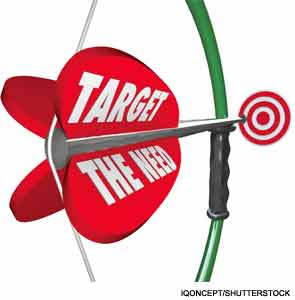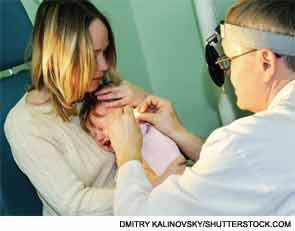
 “If [a practice has] a significant sub-specialty population requiring ongoing care, then I think there is a great opportunity for a nurse practitioner.”
“If [a practice has] a significant sub-specialty population requiring ongoing care, then I think there is a great opportunity for a nurse practitioner.”
—David W. Kennedy, MD
When Ronald B. Kuppersmith, MD, and his colleagues at Texas ENT and Allergy in College Station had the chance to hire a circulating room nurse who had previously worked with the practice as a nurse practitioner (NP), they didn’t waste any time bringing her onboard.
Since joining the practice earlier this year, Genna Lechler, MSN, RN, FNP-c, has been working full time, shadowing the physicians and learning the skillset involved with otolaryngology patient care, with the expectation that she’ll be seeing patients on her own, with physician supervision, in the future. Adding her to the practice means that the clinic is properly staffed to meet patient demand.
Increasingly, otolaryngologists are finding that NPs, physician assistants (PAs) and advanced practice clinicians (APCs) can be valuable assets to their practices, able to handle a variety of tasks related to patient care and address a wide range of patient needs, while also being a cost-effective alternative to bringing on another full-time otolaryngologist. But, knowing how and when to maximize the benefits a physician extender (PE) can offer depends on your specific needs.
A Matter of Supply and Demand
Otolaryngologists should look at the size of their practice, the demographics of their patients and their patient load and then evaluate which types of tasks are stealing their time from surgery and high-level services. Does removing earwax or managing chronic conditions for patients take up the bulk of your day, leaving you less time than you’d like for surgical cases? Does the number of hours you spend in the operating room prohibit you from devoting as much time as you’d like to seeing patients in clinic or examining new patients? After determining where another set of hands could best serve, otolaryngologists need to consider whether a full or part-time PE—who would demand a lower salary than a full-fledged otolaryngologist—could take over some of those responsibilities.
“The physician needs to look at what the primary needs are in that practice,” said David W. Kennedy, MD, professor of otolaryngology–head and neck surgery at the Perlman School of Medicine at the University of Pennsylvania in Philadelphia and co-author of the study, “Changing Practice Models in Otolaryngology–Head and Neck Surgery: The Role for Collaborative Practice (Otolaryngol Head Neck Surg. 2009;141:670-673). “If [a practice has] a significant sub-specialty population requiring ongoing care, then I think there is a great opportunity for a nurse practitioner,” he said. “If they’re spending a lot of time doing patient education that could easily be done by someone else, then that would be a very good time to consider bringing in a nurse practitioner. If they need someone to do additional surgery or additional night-call, then they’ll need an additional otolaryngologist.”
Dr. Kuppersmith agreed that PEs are ideally suited to help with less complicated tasks to free up physicians for more high-level care. “If you have someone who’s trained to do lateral skull-based surgery—let’s say a neurotologist—is it the best use of their time to be cleaning wax out of someone’s ear?” he said. “I think physicians, in general, spend a lot of time doing things they can do, but aren’t necessarily the best people to do them.”
Recognizing long ago the need for a PE in his own practice, Dr. Kennedy employed Christine Riga, an NP who has worked in rhinology for two decades, “and can probably do nasal endoscopy as well as I can,” he said. Riga also co-authored the aforementioned study with Dr. Kennedy. Her ability to perform some in-office procedures, while also handling less technical patient education and medication compliance issues, has afforded Dr. Kennedy more time to see new patients and tend to high-intensity services, such as surgery and post-operative patient care, he said.
Role of an NP, PA
The role of NPs and PAs in otolaryngology practices has widened beyond such routine tasks as removing earwax. Lorin Catalena, MS, PA-C, a PA at Texas ENT and Allergy for the past eight years, said she regularly sees patients with chronic ear infections, tonsil infections, allergic rhinitis, asthma, dizziness and voice disorders and also performs videostroboscopies as part of her services in the practice. For some otolaryngologic surgical procedures, she’ll also see patients for post-operative visits.
“The idea is to save the physician time by performing tasks that are routine, that don’t require the expertise and knowledge that a surgeon has,” Catalena said, noting that she’s built her own patient following at the practice. “Early on, there was some unawareness in the field of what the PA could do for a patient,” she added. “The PA field has grown tremendously through the years, and with it, patients’ knowledge of what a PA can offer to the medical community has grown. Patients understand that a PA can provide excellent medical care and be a trustworthy link between the patient and the physician. There are patients who come in to see me as new patients and for pre-operative visits who feel very comfortable with my knowledge and ability to communicate about their health concerns and the risks and benefits of surgery, if surgery is indicated.”
Hiring PEs can add up to significant cost savings for an otolaryngology practice as well. The median salary for a full-time PA is $90,873, according to statistics compiled by the American Academy of Physician Assistants for their 2010 census. The median salary for a full-time NP is $94,050, according to a 2011 American Academy of Nurse Practitioners’ survey. By comparison, the median salary of a full-time otolaryngologist is $324,272 in 2013, according to salary.com, making the idea of hiring a non-physician very attractive, particularly for smaller practices and busy practices without a large number of surgical patients.
In addition, the training time for an NP or PA—approximately six years versus 11 to 12 years, plus residency, for an otolaryngologist—means that NPs and PAs will be able to move into patient care faster than full-fledged otolaryngologists and may provide a significant share of health care services as our country heads into a predicted physician shortage in the next decade, according to the Association of American Medical Colleges.
“Anytime you add a new salary to your practice, the revenue has to come from some place,” said Dr. Kuppersmith. “It either has to give you more time, or the NP or PA has to generate more revenue, or some combination thereof. If it wasn’t cost effective, people wouldn’t do it.”
Expanded NP, PA Duties
Neil Bhattacharyya, MD, professor of otology and laryngology at Harvard Medical School in Boston, sees the types of roles and duties tasked to PEs expanding even more in the not-so-distant future, as patient demand for otolaryngologic care increases and the workforce of practicing otolaryngologists ages.
In a recent study he conducted, “Involvement of Physician Extenders in Ambulatory Otolaryngology Practice,” Dr. Bhattacharyya contended that “as the U.S. population ages and with predicted increases in chronic conditions such as obesity, diabetes, and allergic diseases, it is further likely that care provided by physician extenders will increase across multiple medical specialties” and that “APCs are expected to expand in numbers in otolaryngology,” (Laryngoscope. 2012;122:1010-1013).
In terms of what that means for otolaryngology, Dr. Bhattacharyya foresees a larger role for PEs in the management of chronic diseases and more complicated patient care.
“About 50 percent or more of what we do relates to diagnosis and chronic disease management,” Dr. Bhattacharyya said. “In one ideal scenario, physician extenders would do the initial evaluation for new patients and get the appropriate diagnostic testing ordered so that when a patient comes back to see the otolaryngologist for their second visit, everything is in place and the otolaryngologist can arrive at the diagnosis and the plan without the patient having to go for a third or fourth visit.”
“In the future, one area [PEs] could move into might be the management of some of these chronic conditions of aging, including hearing loss and dizziness,” Dr. Bhattacharyya added. “The aging population, the obesity epidemic; these are going to lead to more chronic conditions and a greater need for both diagnosis and long-term disease management.”
Impact of the Affordable Care Act
Another factor to consider when gauging the future roles of PEs in otolaryngology is the Affordable Care Act (ACA), which will provide health care benefits to an estimated 25 to 30 million previously uninsured Americans starting next year. With more patients seeking care, an increasing number of NPs and PAs may be the health care providers patients see first, instead of physicians.
“There’s going to be a glut if you will, or an initial front-loading of the whole system with patients that need to be seen,” Dr. Bhattacharyya said. “But I think it’s also one of the components of the ACA that patients can now have NPs and even PAs as their primary provider, so there could be a network of patients that develops into a following for a clinically excellent physician assistant or nurse practitioner in an ENT group.”
Dr. Kennedy agrees that more access to health care coverage may very well spike demand for health care services. “The evidence suggests that the insured population sees physicians more readily than if they’re not insured, so assuming that more people are insured, I think we can say that office visits are going to increase,” he said.
“I think one of the big hurdles that otolaryngology is going to face is how do we best incorporate physician extenders so that they can really help us specifically where the need is going to be,” said Dr. Bhattacharyya. “We need to get more physician assistants and nurse practitioners able to make ENT specific diagnoses, do the otolaryngologic consultation. By 2020, it’s going to be hitting us. We’ve got about three to five years to prepare, maybe a little less.”

Leave a Reply